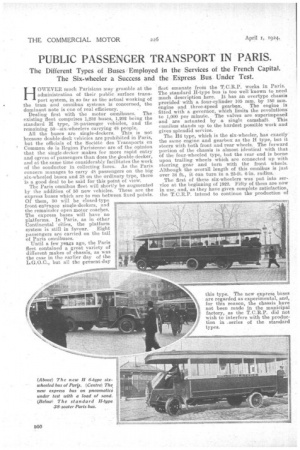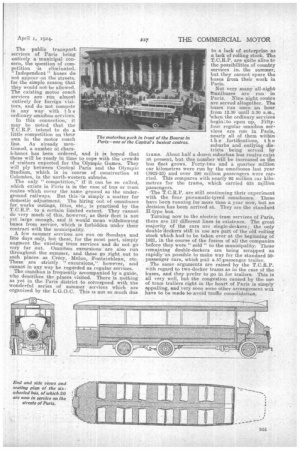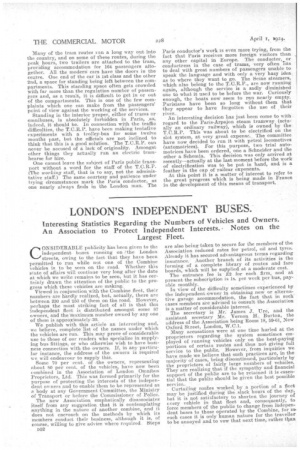PUBLIC PASSENGER TRANSPORT IN PARIS.
Page 44

Page 45

Page 46

If you've noticed an error in this article please click here to report it so we can fix it.
The Different Types of Buses Employed in the Services of the French Capital. The Six-wheeler a Success and the Express Bus Under Test.
HOWEVER much Parisians may grumble at the administration of their public surface transport system, in so far as the actual working of the tram and omnibus systems is concerned, the
dominant note is one of real efficiency. ,
Dealing first with the motor omnibuses. The existing fleet comprises 1,252 buses, 1,202 being the standard H type, 38-passenger vehicles, and the remaining 50—six-wheelers carrying 48 people.
All the buses are single-deckers. This is not because double-deck vehicles are prohibited in Paris, but the officials of the Societe des Transports en Commun de la Region Parisienne are of the opinion that the single-decker makes for more rapid entry and egress of passengers than does the double-decker, and at the same time considerably facilitates the work of the conductor in collecting fares. As the Paris concern manages to carry 48 passengers on the big six-wheeled buses and 38 on the ordinary type, there is a good deal to be said for this point of view. The Paris omnibus fleet will shortly be augmented by the addition of 50 new vehicles. These are the express buses which are to run between fixed points. Of them, 30 will be closed-type . front entrance single-deekers, and the remainder open motor coaches. The express buses will have no platforms. In Paris, as in other Continental 'cities, the platform system is still in favour. Eight passengers are carried on the tail of Paris omnibuses.
Until a, few years ago, the Paris fleet contained a great variety of different makes of chassis, as was the case in the earlier day of the L.G.O.C., but all the prtsent-day fleet emanate from the T.C.R.P. works in Paris. The standard H-type bus is too well 'known to need much description here. It has an overtype chassis provided with a four-cylinder 105 mm. by 150 mm. engine and three-speed gearbox. The engine is fitted with a governor, which limits the revolutions to 1,000 per minute. The valves are superimposed and are actuated by a single camshaft. This omnibus stands up to the hardest possible work and gives splendid service.
The 116 type, which is the six-wheeler, has exactly the same engine and gearbox as the H type, but it steers With both front and rear wheels. The forward portion of the chassis is almost identical with that of the four-wheeled type, but the rear end is borne upon trailing wheels which are connected up with steering gear and turn with the front wheels. Although the overall length of this omnibus is just over 34 ft., it can turn in a 25-ft. 6-in. radius.
The first of these six-wheelers was put into service at the beginning of 1922. Fifty of them are now in use, and, as they have given complete satisfaction, the T.C.R.P. intend to continue the production of
The public transport, services of Paris being entirely a municipal concern, the question of competition is eliminated, "Independent" buses do not appear-on the streets, for the simple reason that they would not be allowed. The existing motor coach services are run almost entirely for foreign visitors, and do not compete in any way with the ordinary omnibus services.
In this connection: it may be noted that the T.C.R.P. intend to do a little competition on their own in the motor coach line. As already mentioned, a number of charsii,liancs has been ordered, and it is hoped that these will be ready in time to cope with the crowds of visitors expected for the Olympic Games. They will ply between Central Paris and the Olympic Stadium, which is in 'course of construction at Colombes, in the north-western suburbs.
The only " competition," if it can he so called, which exists in Paris is in the case of bus or tram routes which cover the same ground as the underground railways. But this").is simply a matter for domestic adjustment. The hiring out of omnibuses for works outings, fetes, etc,, is practised by the T.C.R.P. to a certain limited extent. They cannot do very much of this, however, as their fleet is not yet large enough, and it would mean withdrawing buses from service, which is forbidden under their contract with the municipality.
A few summer services are run on Sundays_ and fete days only, but these, for the most part, simply augment the existing tram services and do not go very far Out. Omnibus excursions are also run throughout the summer, and these go right out to such places as Cr&y, Melun, Fontainbleau, etc. These are strictly " excursions,", however, and i cannot n any way be regarded as ,regular services. The omnibus is frequently accompanied by a, guide, who describes the places visited. There is nothing as yet in the Paris district to correspond with, the wonderful series of summer services which are organized by the L.G.O.C. This is not so much due to a Jack of enterprise as a lack of rolling stock. The T.C.R.P. are quite alive to the possibilities of country services in. the summer, but they cannot spare the buses trona their work in Paris. -Not very many all-night Zrninihuses are run in Paris. Nine night routes are served altogether. The buses run once an hour from 12.30 until 5.30 a.m., when the ordinary services begin;to open up. Fiftyfour regular omnibus ser, vices are run in Paris, nearly all of them within t h efortifications, t h e suburbs and .outlying districts. being served by tiams. About half a dozen suburban bus routes exist at present, but this number will be increased as the bus fleet grows. Fcrty-two and a quarter million car kilometres were run by the omnibuses last year (1922-23) and over 290 million passengers were carried. This compares with nearly 92 million car kilometres for the trams, which carried 624 million passengers.
'The T.C.R.P. are still continuing their experiment with the four pneunaatic-tyred omnibuses. These have been running for more than a year now, but no decision has been arrived at. They are the standard H-type bus.
Turning now to the electric tram services of Paris, there are 157 different lines in existence. The great majority of the cars are single-deckers ; the only double 'deckers still in use are part of the old rolling stock which had to be taken over at the beginning of 192.1, in the course of the fusion of all the companies before they were " sold" to the municipality. These remaining double-deckers are being scrapped as rapidly -'as possible to make way for the standard 50passenger cars, which pull a 57-passenger trailer.
The same argunients are raised by the T.C.R.P. with regard to two-decker trams as in the case of the buses, and they prefer to go in for trailers. This is all very well, but the congestion caused by the use of tram trailers right in the heart of Paris is simply appalling, and very soon some other arrangement will have to be made to avoid traffic consolidation.
Many of the tram routes run a long way out into the country, and on some of these routes, during the peak hours, two trailers are attached to the tram, providing accommodation for 164 passengers altogether. All the modern cars ha-re the doors in the centre. One end of the car is 1st class and the other 2nd, a space for standing being left between the compartments. This standing space often gets crowded with far more than the regulation number of passengers and, as a result, it is difficult to get in or out of the compartments. This is one of the few complaints which one can make from the passengers' point of view against the working of the services.
Standing in the interior proper, either of trams or omnibuses, is absolutely forbidden in Paris, ,as, indeed, it should be. In connection with the traffic difficulties, the T.C.R.P. have been making tentative experiments with a trolley-bus for some twelve months past, but the officials are not inclined to think that this is a good solution. The T.C.R.P. can never be accused of a lack of originality. Amongst other things they actually run an electric tramhearse for hire.
One cannot leave the subject of Paris public transport without a word for the staff of the T.C.R.P. (The working staff, that is to say, not the administative staff.) The same courtesy and patience under trying circumstances mark the Paris conductor, as one nearly always finds in the London man. The Paris conductor's work is even more trying, from the fact that Paris receives more foreign visitors than any other capital in Europe. The conductor, or conductress in the ease of trams, very often as to deal with great numbers of passengers unable to speak the language and with only a very' hazy idea . as to where they want to go. The Seine steamers, which also belong to the T.C.R.P., are now running again, although the service is a sadly diminished one to what it used to be before the war. Curiously enough, the boats now seem to ran nearly empty. Parisians have been so long without them that they appear to have forgotten the use of their river. An interesting decision has just been come to with regard to the Paris-Arpajon steam tramway (actually an ordinary railway), which is owned by the T.C.R.P. This was about to be electrified on the slot system, at very great expense. The committee have now decided to run it with petrol locomotives (automotrices). for this purpose, two trial automotrices have been ordered, one a Schneider and the other a Schemia. This decision was only arrived at recently—actually at the last moment before the work of electrification was to be put in hand, and, is a feather in the cap of railcar exponents. At this point it is a. matter of interest to refer to the great progress which is being made in France in the development of this means of transport.






















































